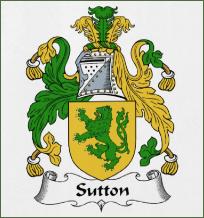 |
||||
Sutton is one of those names that were acquired through the location of the family in its early history. It is from the Anglo-Saxon words, sudh, meaning "south", and tun, meaning "town". Therefore the name designated "the family of Southtown." The Suttons were Normans in the beginning and before anybody had surnames in the modern sense. It is one of the few names which are practically without variants, although one New England forbear tried "Sutten" apparently, however, with indifferent success, as few, if any, of the family now spell it with an "e".
The chronicles of England show the early records of the name Sutton to be derived from the Norman race. There it appears in England from about 1066 A.S., and its history is interwoven within the majestic tapestry which contains the history of England. The first Sutton was a Norman, and in the train of William the Conqueror when he started out upon his never-to-be-forgotten expedition. Sutton-upon-Trent was granted to him as his share of the spoils, to have and to hold forever, and so the Norman became English Sutton. More than 50 coats of arms have been granted to the family, which indicates their rank among the English gentry. There were the Suttons of Sutton in Holdernesse; the Suttons of Sutton-Madoc in Shropshire; and the Suttons of Sutton-in- Ashfield, Nottinghamshire. These were three among the many branches of the family tree planted in England by the Norman founder.
Professional researchers used such ancient manuscripts as the Domesday Book (compiled in 1086 by William the Conqueror), the Ragman Rolls, the Wace poem, the Honour Roll of the Battel Abbey, The Curia Regis, Pipe Rolls, the Falaise Roll, tax records, baptismals, family genealogies and local parish and church records to establish that the first record of the name Sutton was found in Nottinghamshire where they were descended from Drey de Montaigu who came into England at the Norman Conquest in 1066 A.D. in the train of the Count of Mortain. His first seat was at Sutton Montague in Somerset and the family later acquired Sutton upon Trent near Tuxford in Nottingham, where they became Lords of the manor and the Barons Dudley.
The name Sutton, occurred in many references, but from time to time, spellings included Sutton, Suton, Suttone and many others. Scribes recorded and spelled the name as it sounded. It wasn't unlikely that a person would be born with one spelling, married with another and buried with a headstone which showed another spelling.
The Normans were commonly believed to be of French origin but, more accurately, they were of Viking origin. The Vikings landed in the Orkneys and Northern Scotland about the year 870 A.D., under their King, Stirgud the Stout. Later, under their Earl, Thorfinn Rollo, they invaded France about 910 A.D. The French King, Charles the Simple, after Rollo laid siege to Paris, finally conceded defeat and granted northern France to Rollo. Duke William, who invaded and defeated England in 1066, was descended from the first Duke Rollo of Normandy.
The surname Sutton emerged as a notable family name in the county of Nottingham. Many junior branches of this prolific family acquired many estates, during the medieval period, including Norwood Park, Scofton, West Retford, Kelham and Averham in Nottingham.
Amongst the titles in this notable Sutton family are the Barons Lexington, Lords Manners, Viscounts Canterbury, Count de Clonard and many Baronets. Amongst the offices held were, the Archbishop of Canterbury, Lord High Chancellor of Ireland, Speaker of the House of Commons and founders of Brasenose College, Oxford. Outstanding amongst the family at this time was Hervey of Sutton, first Lord of Sutton upon Trent.
The surname Sutton contributed much to local politics and in the affairs of England or Scotland. During the 12 th century many of these Norman families moved north to Scotland. Later in the 16th, 17th and 18th centuries England was ravaged by religious and political conflict. The Monarchy, the Church and Parliament fought for supremacy. The unrest caused many to think of distant lands.
The families of Sutton and Dudley, whose histories are inextricably mingled by intermarriage and relationship, are ancient ones in England, dating before the eleventh century.
In 1251, in the reign of Henry III, Rowland de Sutton married a daughter of the noted family of Lexington. John de Sutton was Lord of Malpas and Shocklech in 1329. There is record of many lands being given to John, son of Richard de Sutton, by Edward III. Isabella de Sutton, after the death of her husband, Knight Sir John de Sutton, in 1359, married Sir Richard de Dudley. Upon her death the estates of the combined families were inherited by her grandson, John Sutton. Among these estates was the famous Dudley Castle.
Other branches of the family were held in high esteem by the people of Holderness in the Province of York, and in Scotland, Ireland, and Wales. The family played a large part in the history of the British Isles.
The most favored Christian names of the early Suttons in America were Joseph, John, Daniel, and Thomas.
There are two coats-of-arms which belong to the families from which the American Suttons are descended. The first, that of the Sutton Dudleys, is "Or, two Lion's passant, bordure engrailed Azure. Crest: Out of a Viscount's coronet Or, pearled Angent, a lion's head Azure, collared gold."
